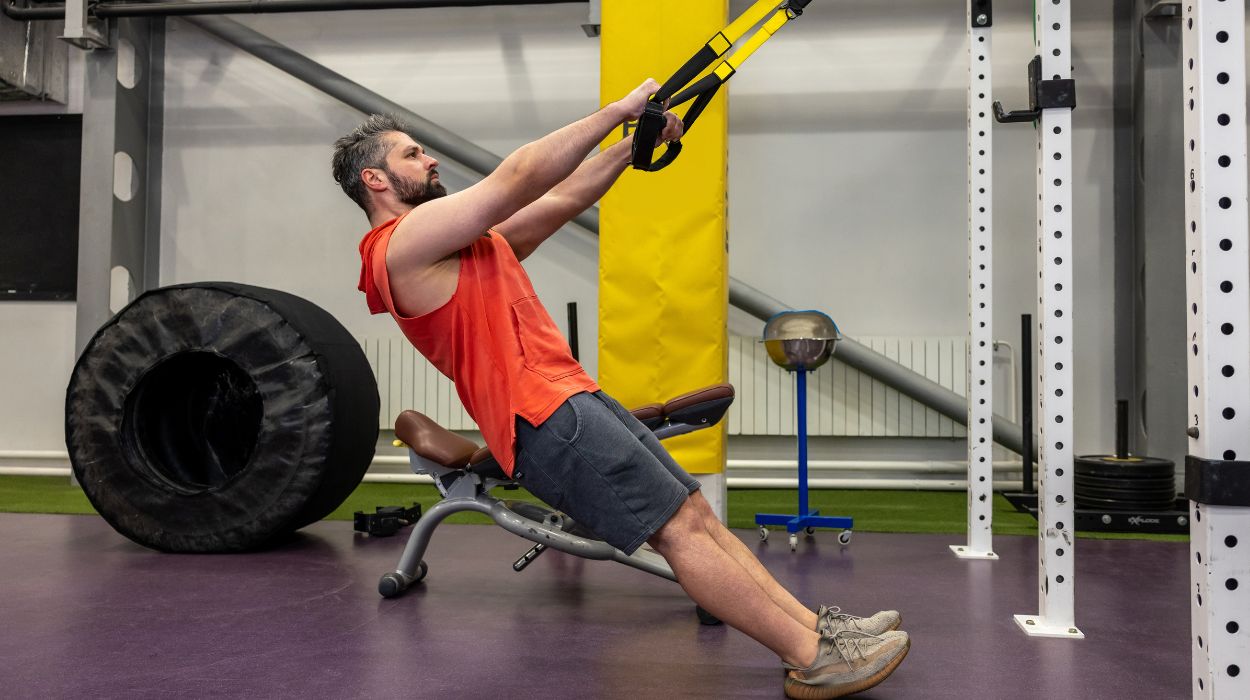
If you’re looking to build strength and muscle in your shoulders, overhead pressing is essential.
There are many ways to get big shoulders, including front and lateral raises. However, these options don’t allow you to load the shoulders with a lot of weight. On the other hand, overhead press variations are perfect for placing heavy loads on the shoulders, instigating muscle growth.
We want to help you reap the benefits of overhead pressing. We have outlined some of the best overhead press exercises and steps for performing them. You can use them in your shoulder workouts or even perform a shoulder superset to push your muscles even further.
Let’s get right into it.
Top Seven Overhead Press Variations
Seven Overhead Press Variations In 2024
Studies have shown that the different shoulder press variations[1] affect the shoulders in varying ways. Here are some of these variations and how to perform them for optimal results.
Standing Barbell Overhead Press
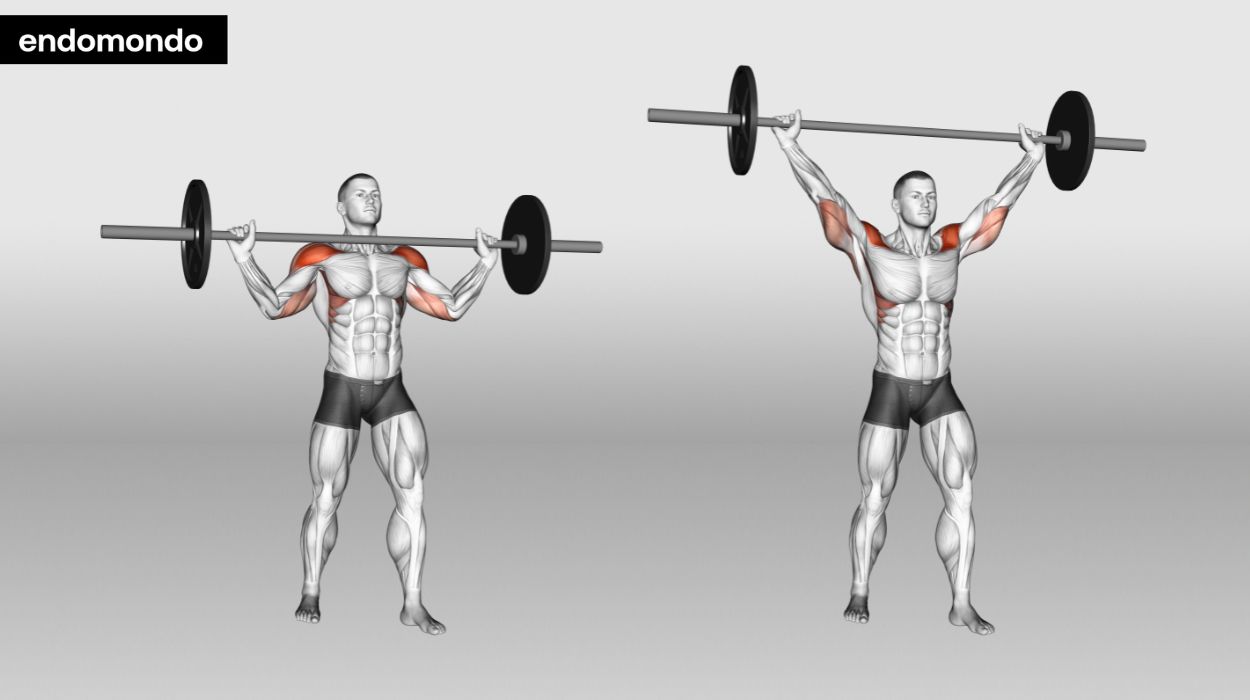
This press is also known as the military press. It is a compound exercise that targets the anterior deltoids, which are the front shoulder muscles. It also engages the triceps, upper chest, middle, and rear deltoid muscles. The military press is performed standing so the core muscles stabilize the body through each set.
This simulates a real-life activity like an overhead pressing movement. People who perform this become stronger and better at lifting everyday things above their heads. The military press’s standing position also improves core stability and balance; the performer maintains an upright position while pushing the resistance over their heads.
This overhead press variation culminates in a better posture for the performer. With this, you want to keep the chest neutral and core engaged while strengthening your shoulders. This will inadvertently teach people to maintain good posture even when they are not exercising.
How to do:
- Set the barbell on a chest-high rack and stand in front of it with your feet shoulder-width apart.
- With your hands slightly wider than shoulder-width apart and your palms forward, grab the bar and lift it off the rack.
- Inhale, then exhale to engage your core and press up until your arms are fully extended.
- Move your head back slightly as the bar goes up, and bring it back forward once it is overhead.
- Controlling the descent, bring the bar down to chest or shoulder level.
- Repeat the movement.
Tips:
- Engage your core and glutes to stabilize your body throughout the lift.
- Maintain straight wrists and avoid bending them backward.
- Inhale before lifting, and exhale as you push the bar up.
- Make sure you warm up – start with a manageable weight to perfect your form before increasing it slowly.
Optimal Sets And Reps: 3 to 4 sets of 8 to 12 reps.
Seated Dumbbell Shoulder Press
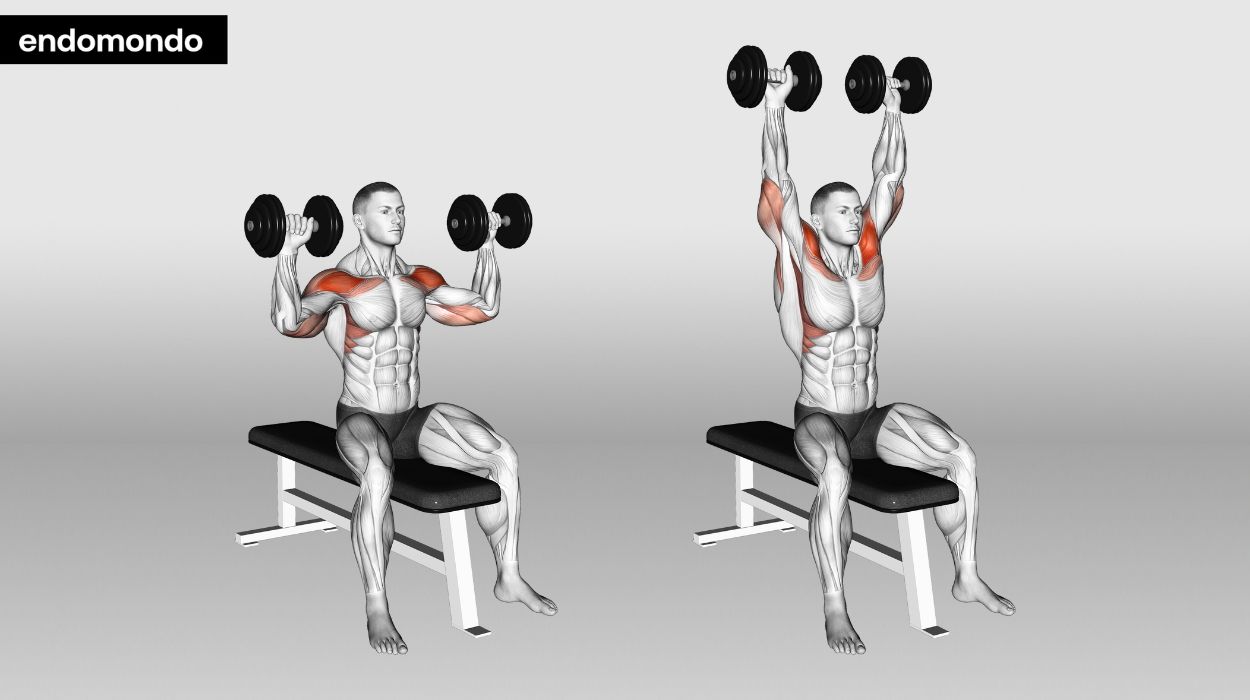
The seated dumbbell shoulder press targets the deltoids, and its main emphasis is the front delt. This exercise’s versatility allows you to hit other parts of the delt, like the side and rear delts. Using dumbbells, you can rotate your shoulders outward to better target these parts of the shoulder.
Isolation is one of the biggest advantages of seated dumbbell press variation. You perform the exercise sitting on a bench; therefore, you don’t use as much leg drive, glutes, and core strength as you would in a standing variation. This targets the shoulders, ensuring they perform most of the work in the lift.
Additionally, dumbbells enable balance and symmetry; each shoulder works independently to increase the weight. This corrects imbalances and ensures even muscle development. This dumbbell shoulder workout also allows you to adjust your grip and arm angle.
How to do:
- Grab a pair of dumbbells and sit on a bench with back support, placing the dumbbells on your knees.
- Use your legs to push the dumbbells up to shoulder or chest height.
- Keep your palms facing slightly forward and your shoulders tucked in. When exhaling, press the dumbbells straight up over your head until your arms are fully extended.
- Slowly lower the dumbbells back to the shoulder or chest-height starting position to perform another rep.
Tips:
- Warm up with lighter dumbbells to prepare your joints and perfect your form before your main set.
- Aim to push the dumbbells up in a straight line above your shoulders. Pressing with a slight arc would also work.
- Control the dumbbells when they are coming down. Make sure you bring them down slowly to maximize muscle engagement and reduce the risk of injury.
- Exhale when pressing up and inhale when returning to the starting position.
Optimal Sets And Reps: 3 to 4 sets of 8 to 12 reps.
Push Press
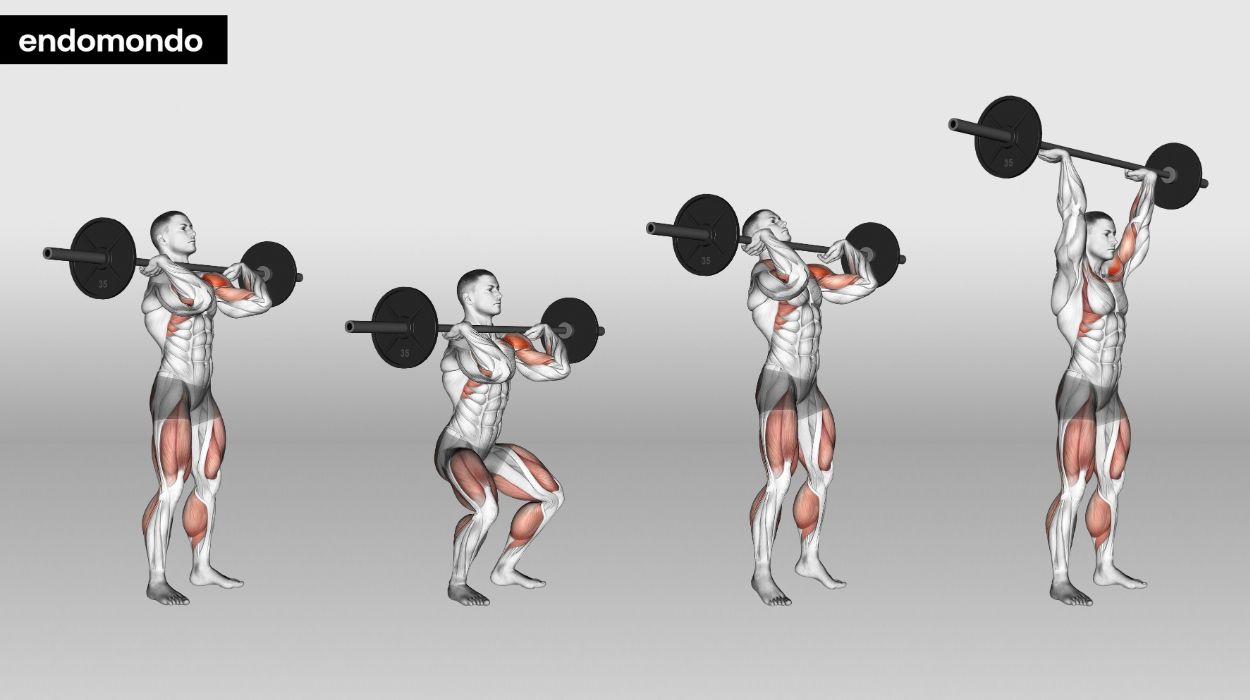
The push press is a dynamic overhead pressing workout that mixes power, strength training, and force development elements. It focuses on the deltoids like the seated dumbbell shoulder and military presses.
However, it differs from them because it incorporates a slight knee bend to generate momentum. This small change allows you to use more lower-body drive, resulting in heavier lifts and more reps.
Because the push press incorporates leg drive, it requires full body coordination. It involves upper body muscles like the deltoids and triceps and lower body muscles like the quadriceps. Your core muscles also play a huge role in stabilizing you through each rep.
Most of the push press’s benefits relate more to strength than hypertrophy. The workout develops explosive power for sports and day-to-day activity. It may also provide variety if your presses start to feel monotonous or you’re stuck on a plateau.
How to do:
- Stand with your feet shoulder-width apart, holding a barbell at shoulder level and your elbows out in front.
- Slightly bend your knees and hips, keeping your torso upright.
- Quickly straighten your legs, drawing momentum from them to push the bar over your head.
- Slowly bring the bar back down to your shoulders.
Tips:
- Keep your core engaged throughout the workout to stabilize your body and protect your spine.
- The initial momentum should come from your legs. Focus on a good dip and push.
- Start with your elbows slightly in front of the bar from a strong pressing position.
- Press the bar straight up, and move your head back slightly as it passes your face, bringing it back forward when you’ve straightened your arm.
Optimal Sets And Reps: 3 to 5 sets of 6 to 12 reps.
Arnold Press
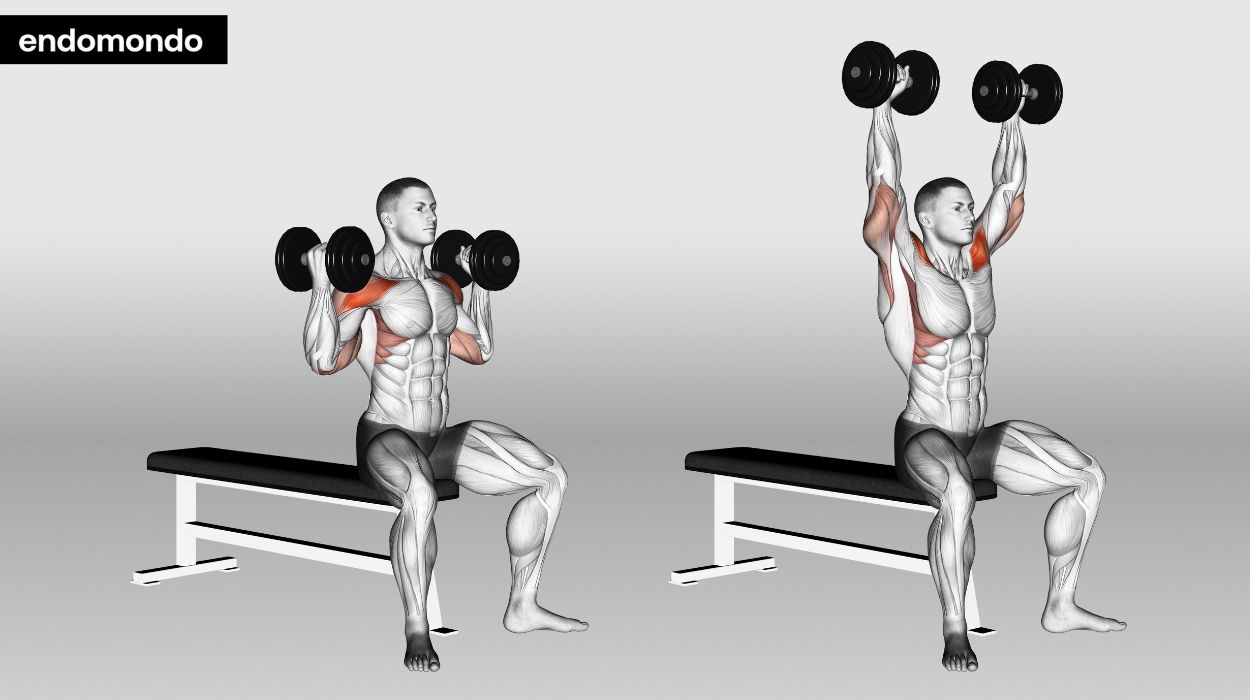
This is a unique shoulder press variation. It involves pressing and rotating the dumbbells, targeting the shoulders from multiple angles. Named after Arnold Schwarzenegger, who popularized it, this also engages the traps and triceps.
The rotation aims to hit all the parts of the shoulders at the same time – the front, side, and rear delts. The workout also challenges flexibility and stability as it takes some deep range of motion abilities to execute. The press may also be difficult to balance, especially when performed standing, so it requires a strong core.
As challenging as the press may seem, it can be adapted to various fitness levels by adjusting the weight of the dumbbells used for the workout. So, beginner and advanced lifters alike can engage in this to get massive shoulders.
How to do:
- Sit or stand holding two dumbbells in front of you at chest level, palms facing you. Sitting is expedient because you can isolate your shoulders.
- In one fluid motion, press the dumbbell overhead while rotating your arms outwards so that your palms face forward at the top.
- Lower the dumbbells back to the starting position, rotating your palms towards you again.
Tips:
- Move slowly and deliberately, focusing on the rotation to fully engage the muscles.
- Make sure both arms rotate evenly to maintain symmetry in growth.
- Start light to properly learn how to execute the workout and slowly increase the load.
- Use your exhalation to keep your core engaged throughout the exercise for stability.
Optimal Sets And Reps: 3 to 4 sets of 8 to 15 reps.
Landmine Press
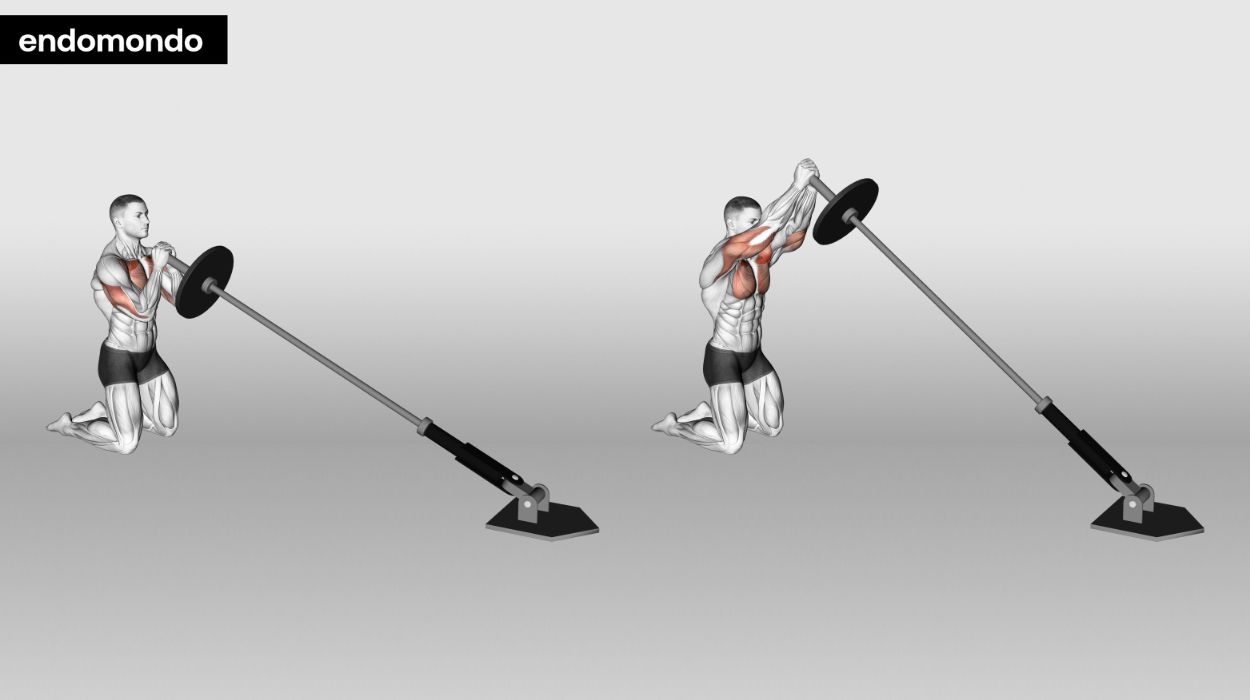
The press uses a barbell anchored at one end to create a pivot for different movement types.
Since one end of the barbell is anchored in a corner, the other end holds the weight plates. It is pressed forward and upwards with one hand. This is done either from a sitting or standing position.
The press focuses on the front delts, like most shoulder workouts in this list, but it trains the triceps, upper chest, and serratus anterior. It also targets the core, as unilateral movement requires more core strength to keep the body up and stable.
One benefit of the press is its functionality. While helping you to build big delts, it simulates a natural, everyday movement. It also causes less stress on the joints than other traditional overhead presses.
It’s perfect for people who are recovering from injury and athletes looking to improve upper-body strength.
How to do:
- Anchor one end of a barbell in a secure corner.
- Standing or kneeling facing the barbell, pick up the free end with one hand and hold it up at shoulder height.
- Extend your arms to press the barbell upwards and slightly forward, following its natural arc.
- Complete the desired number of reps and switch to the other arm to complete the set.
Tips:
- Keep your core engaged throughout the exercise.
- Keep your elbow close to your body.
- Relax your shoulders and keep your chest up.
- Allow the barbell’s arc to lead you as you raise it and slowly bring it down.
Optimal Sets And Reps: 3 to 5 sets of 8 to 15 reps.
Single-Arm Dumbbell Overhead Press
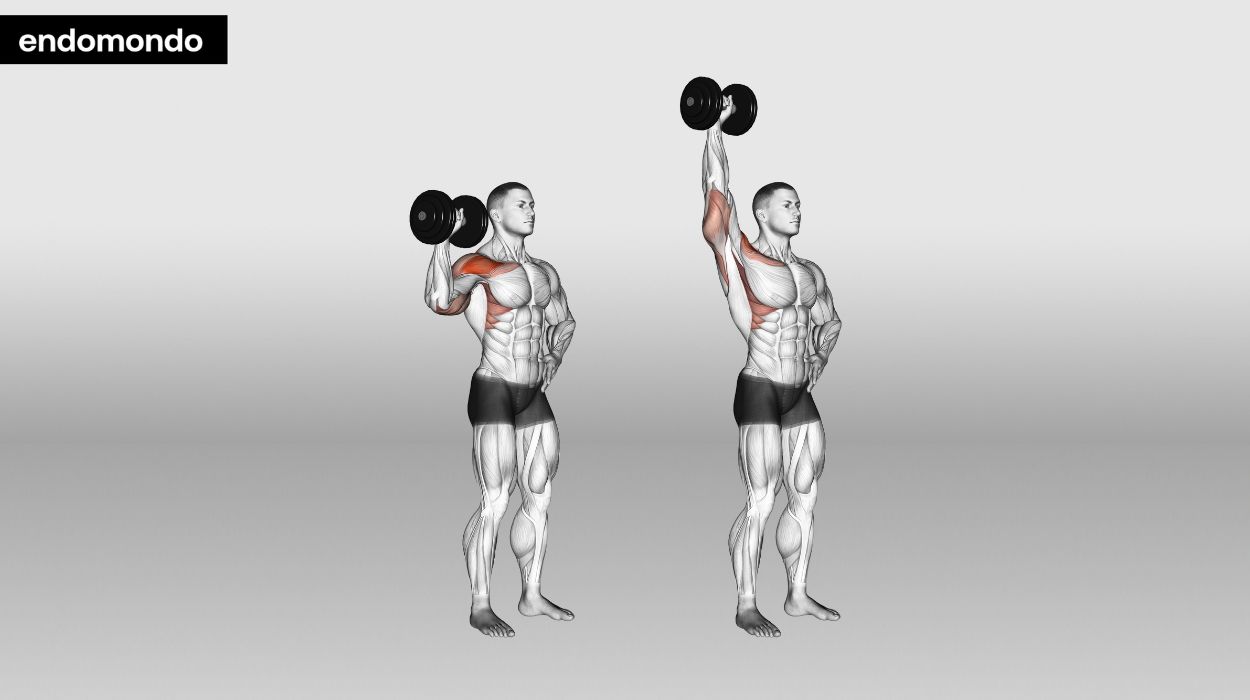
As its name suggests, the single-arm dumbbell overhead press involves pressing a dumbbell overhead with one arm. You can perform this standing or sitting. You want to focus on maximally contracting your front delts while activating both the rear and side delts.
Like other basic overhead variations, the single-arm dumbbell overhead press also works the triceps. It recruits the upper chest muscles to get the dumbbell over your head. Because this only involves one arm at a time, the core plays a role in maintaining balance.
The single-arm press is a lot like the landmine press in its functionality. It mimics everyday activity and is a great option for people trying to infuse some functionality into their resistance training. Additionally, this would fit right into an arms and shoulders workout day – it doesn’t require very heavy weights and does not task the shoulders much.
How to do:
- Sit or stand, holding a dumbbell at shoulder or chest height with your palms facing forward.
- Extend your arm overhead, keeping it close to your head.
- Pause briefly at the top, then slowly lower to the starting position.
- Perform the desired reps, then switch the dumbbell to the other hand to complete the set.
Tips:
- Don’t use a dumbbell that’s too heavy.
- If you’re performing the workout standing, keep your feet at least shoulder or hip-width apart for good balance.
- Maintain a neutral spine and avoid arching your back as you press up.
- Use your exhalation to engage and tighten your core muscles.
Optimal Sets And Reps: 3 to 5 sets of 6 to 12 reps.
Z Press
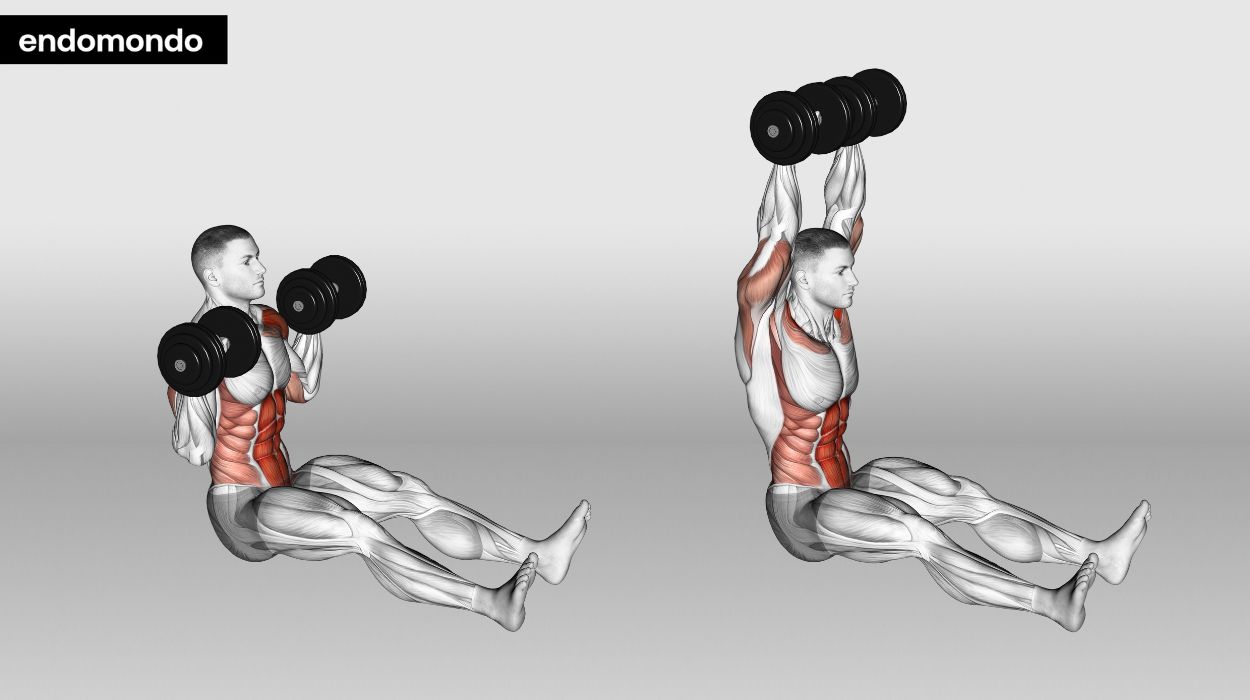
This is a tasking barbell shoulder workout. Fundamentally, it’s a military press, but there’s a big twist – you raise the bar while sitting down on the floor with your legs stretched out in front of you. This is more difficult because there’s no lower-body support.
The Z press targets the deltoids and triceps. On a normal press, you’re either standing or sitting on a bench with a backrest. In this workout, however, you’re doing neither, so there’s no support either from the backrest or your legs.
This means your core has to hold your body up. Hence, this requires immense core strength.
While it is quite difficult, this workout also has immense benefits. It improves shoulder strength, which transfers to other movements. It also builds strength because it forces your abdominal and lower back muscles to work.
How to do:
- Sit down on the floor with your legs straight out in front of you.
- Place the bar on a platform directly in front of you from which you can easily lift it.
- Inhale, then exhale to lift the bar to shoulder or chest level and push it overhead in a straight path.
- Push your head back to allow the bar to pass and return your head to its previous position once the bar is overhead.
- Slowly bring the bar back to the starting position and press again.
Tips:
- Don’t lift the bar from the ground while sitting down. That could complicate things and cause injury.
- Keep your back straight. Do not bend it.
- Control the weight, especially on the eccentric part.
- Keep your legs and glutes firmly on the ground.
- Engage your core muscles to stabilize your posture.
Optimal Sets And Reps: 3 to 4 sets of 8 to 12 reps.
Benefits Of Each Variations
Standing Barbell Overhead Press
This press is great for loading the shoulders, especially the front delts. While other pressing variations will likely instigate growth, nothing loads the shoulders like a barbell with plates stacked on each side. While more weight does not necessarily mean more muscle activation, research has shown that resistance training[2] is necessary for growth.
Seated Dumbbell Shoulder Press
The seated dumbbell shoulder press allows for more balance. Also, because a dumbbell is held in each hand, you can bring the weights down to your chest without straining your joints.
This makes for a better range of motion and muscle activation. Muscle activation[3] in the front delts is higher with dumbbell shoulder press variations.
Push Press
The push press allows you to perform the military press with a small cheat. This way, you can increase the weights you lift. It is a great alternative to the basic military press if you prefer strength training or lifting with momentum.
Arnold Press
The Arnold press kills two – no, three birds with one stone, as it allows you to train the three heads of the shoulders at once. When the Arnold press was compared to the overhead dumbbell press, the Arnold press activated both the anterior and medial delts[4] better.
Landmine Press
This variation’s biggest selling point is its functionality and its usefulness as a strength and power builder for athletes. It is suitable for trainees who are more interested in functional strength than muscle building.
Single-Arm Dumbbell Overhead Press
The single-arm dumbbell overhead press is another that is praised for its functionality. It also tasks the core to uphold the body because it involves only one side. If you’re looking for a workout that grows the delts and works the deep core muscles simultaneously, this is it.
Z Press
The Z Press is one of the most difficult shoulder workout variations because it eliminates leg drive and back support. It’s a great option for improving shoulder strength and easing through workout plateaus. It also develops strength in the core and builds strength in other lifts, such as the bench press.
Muscles Worked By The Overhead Press
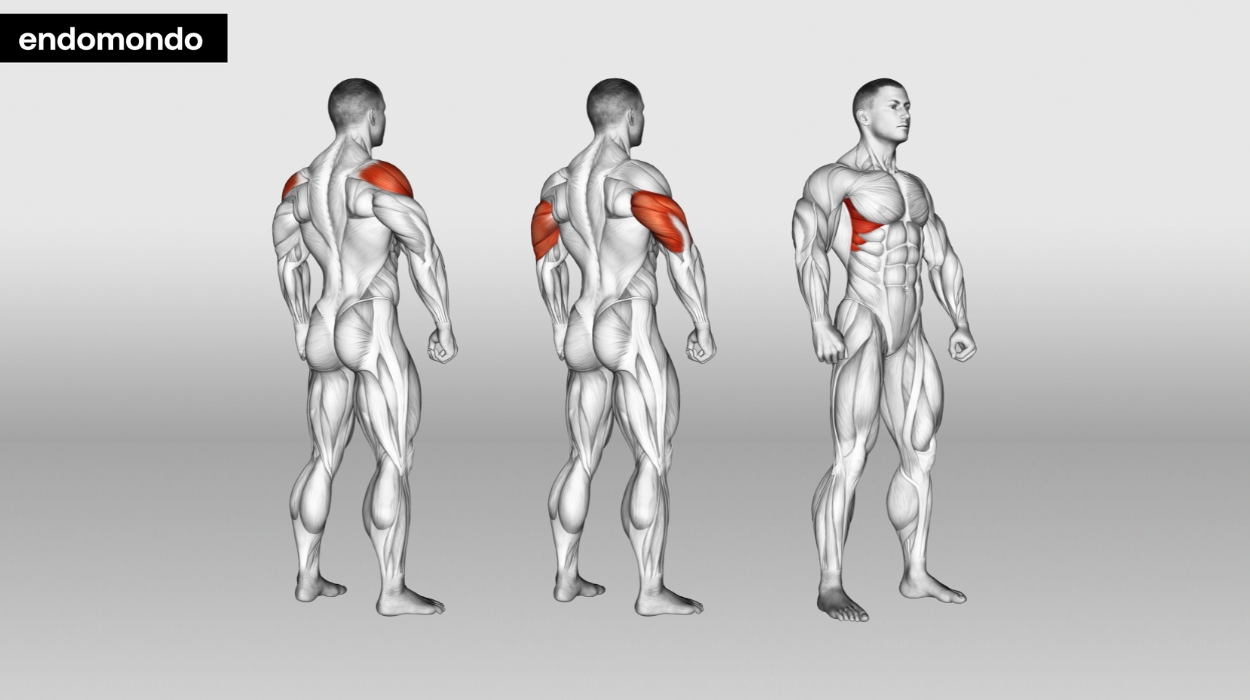
The primary muscles worked during the overhead press are the deltoids.[5] These muscles consist of the front, side, and rear heads.
Most variations bias the front delts because the hands are tilted slightly toward the front. However, the best variations recruit all the shoulder muscles.
The triceps also play a huge part in the overhead press, as in any strict press. Other secondary muscles involved in overhead pressing movements are the shoulder stabilizers[6] – the pectoral muscles, the serratus anterior, and the traps.
Overhead Press Form Tips
There are many overhead press variations, including specific shoulder workouts for men and shoulder workouts for women. Nonetheless, some tips and cues can guide anyone looking to perform safe, optimal shoulder pressing, regardless of variation.
Maintain Your Stance
If you’re standing, place your feet apart and slightly bend your knees to enable lower body support. If you’re sitting, properly lock yourself into the seat.
Perfect Your Grip
Hold the dumbbell, barbell, or any other implement firmly in your palms and avoid bending your wrist. Start the movement at shoulder or chest height, depending on how low your range of motion can go.
Brace Your Core And Breathe Properly Through Each Rep
Tighten your abdominals and back muscles throughout each rep. Exhale when pressing up and inhale on the way down.
Don’t Flare Your Elbows
Try to keep your elbows and shoulders tucked to protect these joints. A good cue is to keep your elbows just under your wrist and out in front of your shoulders.
Don’t Lock Out Your Elbows
While locking out your elbows while pressing won’t destroy them; it is expedient not to because your shoulders aren’t active in that range of motion. Also, locking puts unnecessary strain on your elbows.
Conclusion
To grow the delts, there are many cable shoulder workouts you can implement. You can also train them with other muscles.
For example, a shoulder and bicep workout is a great way to break the mold. However, while these would grow your shoulders, they may not do much to strengthen the muscles in the joint.
The overhead press, on the other hand, is an effective compound movement for both strength and muscle growth. If you think the most basic variations are monotonous, you could try other functional variations, like the landmine press.
Incorporate these into your next shoulder workout and see the difference. You can experiment with all of them and stick with the ones you like best. You can also prioritize ones that suit your fitness goals more, whether it’s strength, muscle growth, or general functional training.
Frequently Asked Questions
The best type of overhead press for your shoulders depends on your specific fitness goals, shoulder health, and individual preferences. The standing barbell overhead press and seated dumbbell press are great options for building muscle and strength.
You can build muscle in the shoulders without the overhead press. However, other popular shoulder workouts, like lateral raises, don’t allow you to load the shoulders with heavy weights. Overhead presses do; hence, they are integral to shoulder training.
When performed with proper form, overhead pressing is safe for many. However, people with poor shoulder mobility, shoulder injuries, a history of shoulder dislocation, and poor shoulder mobility may be better off with simpler shoulder workouts.
Resources
- Coratella, G., Tornatore, G., Longo, S., Esposito, F. and Emiliano Cè (2022). Front vs Back and Barbell vs Machine Overhead Press: An Electromyographic Analysis and Implications For Resistance Training. Frontiers in Physiology, [online] 13. doi:https://doi.org/10.3389/fphys.2022.825880.
- Krzysztofik, M., Wilk, M., Grzegorz Wojdała and Artur Gołaś (2019). Maximizing Muscle Hypertrophy: A Systematic Review of Advanced Resistance Training Techniques and Methods. International Journal of Environmental Research and Public Health, [online] 16(24), pp.4897–4897. doi:https://doi.org/10.3390/ijerph16244897.
- Dicus, J.R., Holmstrup, M.E., Shuler, K.T., Rice, T.T., Raybuck, S.D. and Siddons, C.A. (2018). Stability of Resistance Training Implement alters EMG Activity during the Overhead Press. International journal of exercise science, [online] 11(1), pp.708–716. Available at: https://www.ncbi.nlm.nih.gov/pmc/articles/PMC6033506///.
- Shiny Raizada and Bagchi, A. (2017). Comparison among the EMG Activity of the Anterior Deltoid and Medial Deltoid During Two Variations of… [online] ResearchGate. Available at: https://www.researchgate.net/publication/322132613_Comparison_among_the_EMG_Activity_of_the_Anterior_Deltoid_and_Medial_Deltoid_During_Two_Variations_of_Dumbbell_Shoulder_Press_Exercise.
- Elzanie A;Varacallo M (2024). Anatomy, Shoulder and Upper Limb, Deltoid Muscle. [online] Available at: https://pubmed.ncbi.nlm.nih.gov/30725741/.
- Williams, M.R., Hendricks, D.S., Dannen, M.J. and Lawrence, M. (2018). Activity of Shoulder Stabilizers and Prime Movers During an Unstable Overhead Press. [online] ResearchGate. Available at: https://www.researchgate.net/publication/325679785_Activity_of_Shoulder_Stabilizers_and_Prime_Movers_During_an_Unstable_Overhead_Press.




